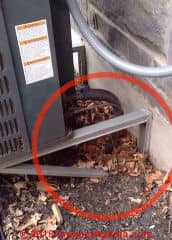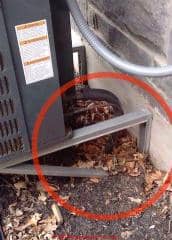 Air Conditioning Refrigerant Line FAQs
Air Conditioning Refrigerant Line FAQs
- POST a QUESTION or COMMENT about HVAC system refrigerant piping or tubing routing, connections, materials, charging
Refrigeration equipment piping questoions & answers for installing air conditioners & heat pumps:
How-to and diagnostic questions & answers about the installation of HVAC refrigerant system piping or tubing.
These questions add details about selecting, mounting, and connecting refrigeration tubing or piping used in air conditioner & heat pump systems.
This air conditioning repair article series discusses the refrigeration piping requirements, insulation, mechanical fastening, and allowable distances as well as errors in air conditioning refrigerant piping installations that risk future refrigerant leaks or malfunction in the cooling equipment.
InspectAPedia tolerates no conflicts of interest. We have no relationship with advertisers, products, or services discussed at this website.
Air Conditioner Refrigerant Line Questions & Answers
 These questions & answers about refrigerant gas piping installation, repair, troubleshooting were posted originally at REFRIGERANT PIPING INSTALLATION - be sure to review that article.
These questions & answers about refrigerant gas piping installation, repair, troubleshooting were posted originally at REFRIGERANT PIPING INSTALLATION - be sure to review that article.
On 2018-08-26 7 - by (mod) - cracked flare fittings in small air conditioners?
Yossi
We do not ever use flare fittings on refrigerant piping as they're not likely to withstand the pressures involved on the high side.
I think you probabaly mean swaged connections: one end of the copper tubing is enlarged to permit joining two sections of copper piping.
The swage joint is then soldered or brazed. Some swaging tools are shown in my photo.
Swage joints are discussed
at REFRIGERANT PIPING INSTALLATION
On 2018-08-26 7 by YossiD
A friend of mine is having some problems with a room sized split air conditioner in his home. The unit is about three years old.
A few months ago the unit stopped cooling and an air conditioning technician confirmed that the gas had leaked out.
To inspect the lines some drywall had to be removed form a lowered ceiling, and upon inspection a cracked flare nut was found. The technician said that this is a not uncommon occurrence.
Have you ever come across cracked flare fittings in small air conditioners? It seems to me that it's just a case of poor quality fittings. What do you think?
Anyway, the damaged fitting was replaced and the unit again functioned properly.
now my friend is having more trouble with the same unit, and the technician says that now there is leaking in the copper tubing itself.
This is also a new on one me. The tubing was professionally installed and there are few bends. Unfortunately the tubing is in the wall, and partly behind a tiled bathroom wall, so revealing all of it to find the point of failure will be serious undertaking.
My friend is thinking of rerouting for convenience though the result will not be as aesthetic and the rerouted tubing will inconveniently routed on the roof of his home, where the compressor is located.
Do you have any experience with leaks in copper tubing except at bends or points of "trauma?" Is the kind of cheap Chinese Fe-Al contaminated Cu tubing mentioned in Robert W Porter's post prone to leaking?
Thanks for any insights.
On 2018-07-04 by Robert W Porter
Our house was built 2000-2001 when cheap Chinese cu tubing made with Fe-Al contaminated Cu tubing was first imported, especially in FL. Our CA house had a single such water line leak which was fixed with a 4-in line insert.
Now one of two AC units has a seasonal leak, the one with a longer run of Cu tubing. Leak sealant was tried unsuccessful.
The run to and from the evaporator (replaced a few years ago) is long, 50-75 feet in attic under insulation. Should we try to find lead (how?) or replace it all, including vertical runs?
On 2018-06-21 by (mod) -
James
Halogen based A/C or heat pump refrigerants are not explosive, though lubricants and oils might be flammable.
The danger to the equipment is contaminating the refrigerant system, clogging the expansion valve, or damaging the compressor motor.
A tech would evacuate the system, do the soldering, install a burnout dryer, maybe two of them, then change out the dryer again after a few months - all trying to avoid contamination clogs.
On 2018-06-21 by James
While installing an outdoor unit and prepare it for service, found leak after opening hex ports for the first time, wanted to solder but don't know if there are dangers to me or the equipment?
On 2018-03-13 by (mod) -
Kash, Please see your question and my detailed answer now found at REFRIGERANT PIPING UNDERGROUND or BURIED at https://inspectapedia.com/aircond/Buried-Refrigerant-Piping.php
where I moved material to a separate page to have space for discussion and illustration.
Let me know if you have further questions, and thanks again for asking.
Daniel
On 2018-03-13 by (mod) - is it OK to bury air conditioning, heat pump, or other refrigerant lines
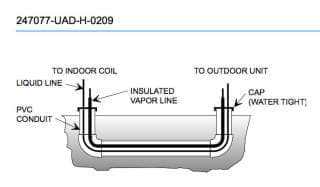 Kash:
Kash:
Thank you for an excellent question that I might re-phrase as "is it OK to bury air conditioning, heat pump, or other refrigerant lines"
Watch out: The answer is: yes sort-of. The concern is that running refrigerant piping underground invites the accumulation of liquid refrigerant in the return or suction line. In turn that condition can cause liquid slugging at the compressor motor.
That in turn destroys the compressor.
Here is what Johnson Controls advises where refrigerant piping must be buried:
Use PVC piping as a conduit for all underground installations.
See the figure above. Buried lines must be kept as short as possible to minimize the build up of liquid refrigerant in the vapor line during long periods of shutdown.
I will add this and other citations in the article above. We can't know from just your photo how much buried piping is installed at the home in your photo nor exactly where it is routed.
It MIGHT be that the only buried piping is vertical and that in this specific instance it's not damaging the compressor - but the possibility is certainly there. Kudos to your home inspector.
The refrigerant piping is not following the industry-recommended practice.
On 2018-03-13 by Kash
During the home inspection of the 1-year-old house, the inspector pointing out the AC piping lose, improperly run/buried, find attached the picture please advise if anything wrong with that or not and if it's not right what needed to be done. Thanks in Advance.
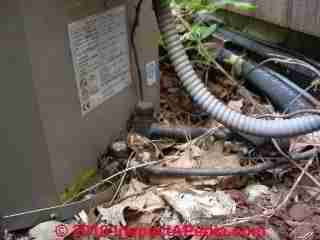 On 2018-08-28 by (mod) - Refrigerant piping should be protected from physical or mechanical damage
On 2018-08-28 by (mod) - Refrigerant piping should be protected from physical or mechanical damage
Refrigerant piping should be protected from physical or mechanical damage by either routing or shielding.
For example where a line runs through a wooden stud you'd use nail plates to keep someone from driving a nail through the line.
See https://inspectapedia.com/aircond/Refrigerant_Piping.php REFRIGERANT PIPING INSTALLATION
On 2018-08-28 by Des de Souza
Route of the freon line from the ac unit to the air handler. This goes up the side of my house and under the roof line.
The last time I had a new roof, the roofers punched a hole in the freon line. Is there a code on whether the line should be installed low enough to prevent this from happening?
On 2018-06-24 by (mod) - missing vibration dampening loop in refrigerant piping
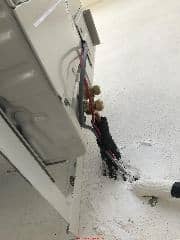 yes the short pipe is likely to risk refrigerant leaks because it doesn't allow The extra length which would accommodate vibration and movement.
yes the short pipe is likely to risk refrigerant leaks because it doesn't allow The extra length which would accommodate vibration and movement.
On 2018-06-24 by Walter Sui
I just installed sharp split AIRCON.
The product leftlet mention about minimum pipe length of 3m, but my final pipe seem only less then 50cm between the outdoor and indoor unit.
Do this short pipe length cause any trouble to the indoor unit or outdoor condenser?
Hope to get reply to release my worry
On 2018-06-24 by (mod) -
Yes if they are in good condition.
On 2018-06-24 by john
I have an old lennex unit and it finally died. Can a new outside unit be replaced and still use all the existing lines that go into house?
On 2018-06-02 by Matt
Can copper water pipe b used as the line set for central air conditioning?
On 2017-08-05 by (mod)
Good luck on your test, Ahmed.
On 2017-08-05 by Ahmed
the tubing intended for refrigeration and air conditioning installation should be - ----
On 2017-07-12 by (mod) - signs of low refrigerant
sure, Johnny.
The sight glass will show bubbles of gas and loss low refrigerant in the liquid line of the refrigerant piping system for virtually all refrigerant types.
On 2017-07-10 by Johnny P
Just changed my entire ac system .
Now have a matching 14seer 4ton Rheem system.
I had a sightglass in the old 3/8 freon line.
Do I still use the sightglass since I changed from freon22 to r410a ? ( yes it's an expansion valve coil )
On 2017-05-21 by (mod) - ok to use larger diameter refrigerant piping
My opinion And I'm surely not the last word on this, is that you're always safer with a larger-diameter refrigerant line. However don't forget that you will need to adjust the refrigerant charge accordingly
Watch out: there may be increased leak risks with larger diameter refrigerant piping in locations subject to mechanical stress from vibration or settlement or movement of the equipmenbt as it's more difficult to include an extra loop of tubing or piping to permit movement without breaking connections.
On 2017-05-21 by Anonymous
Sorry for confusion suction line is 3/8 on condenser unit, but ducted airhandler unit has 1/2". I was going to use 1/2" but wasn't sure. I could find any manufacture instructions. Brand is Midea.
Thanks
On 2017-05-20 20:32:16.496281 by (mod) -
Alex, thank you for asking I'm sorry but I'm not sure what is the right answer. We would need to find the brand and model and check with manufacturers technical support. Something sounds strange to me. unless we are talking about a heat pump., as I am sure you know usually the suction line is the larger diameter
On 2017-05-20 12:20:54.554351 by Alex
Hi,
I’m installing mini split tri zone condenser unit with 3 ducted airhandler units. They are same brand. All 3 zones on condenser unit has 1/4” for suction and 3/8” for discharge lines. Two airhandler units match line sizing, but one unit has 1/4” for suction and 1/2” for discharge.
What line size should I use 3/8” or 1/2"?
Thank you.
On 2017-10-14 21:15:29.956412 by Don
Unit was placed in attic because
1) we were renovating the 1910 house and had most of the roof removed,
2) we were concerned about getting A/C to the 2nd floor (had problems with another 2 story house),
3) were concerned only about A/C on 2nd floor since we live in Pacific NW and there are not that many hot days.
We have never had any issues with the unit not heating or cooling.
The sound seems to be more prevalent after heating than cooling. Thanks for the observations - will get my HVAC guy to check the pressure.
On 2017-10-14 20:23:12.285635 by Don
American Standard -10 years old. Thumping sound transmitted through wall from the refrigerant line connecting indoor unit with compressor.
Occurs after A/C or heat has stopped blowing. Last for minutes; slowly gets less then stops.
Replaced the reverse valve and seemed to stop for a while but has now started again. Indoor unit is in the attic; outdoor unit is beside the house; line runs through wall between both. Any ideas?
On 2017-09-28 20:25:43.460824 by (mod) -
Miguel,
I agree that it sounds like the air conditioning refrigerant system is leaking. It might be possible to use a leak detection device to find the leak. That would be a happier approach and less costly approach than simply replacing everything.
On 2017-09-28 19:56:50.176350 by Miguel
1yr and 1/2 ago a friend install an a/c unit brand new for the 1,1/2 yr he had come three times to put freon he said the main lines are leaking there for must be replace but throw the attic is this true why not underneath the house
On 2017-09-17 16:42:23.147144 by (mod) -
Richard,
About changing the direction of flow of refrigerant - a standard and fundamental step in the operation of heat pumps when changing between heating and cooling modes - is done by a reversing valve.
Take a look in your documentation and read up on that device.
On 2017-09-17 16:41:34.239350 by (mod) -
Marroq
Start by looking at the brand and data tag on your equipment.
Then call the manufacturer's service support line for an opinion about minimum refrigerant line size, or get a copy of the installation and operation manual for your unit.
There you'll see that the refrigerant line size required might depend on the total system capacity and also the length of piping runs.
But normally changing refrigerant itself wouldn't require new refrigerant piping.
A mis-match between the outdoor compressor/condenser unit and the indoor air handler and cooling coil could be a problem.
None of these would explain a sudden death of a new compressor unit. More likely there was an installation error. Something as simple as the wrong quantity of refrigerant charge or an improperly-functioning refrigerant metering valve can send liquid refrigerant to a compressor - killing it.
On 2017-09-17 04:59:42.533812 by marroquinsevastian
AC tech replaced outside unit due to compressor failure. After three weeks not cooling got somebody else to look at it. He said that the piping was the wrong size due to the new freon and that the unit was the wrong size. Compressor started making nosie and died. How can I tell if the piping and unit are the right size.
On 2017-09-08 04:58:06.108675 by Richard
I'm doing a assignment on a/c refrigeration and I came up in a question in the duccument saying. explain how you change the direction when installing hard draw refrigeration piping. I don't understand what that mean. please help me.
On 2017-08-23 08:17:01.168578 by hussein
what occur air and Freon gas split unit .
On 2017-07-28 by Jyo Gupta
Thanks for the insights, Daniel! That really helps.
I actually wanted to get a basic idea about the minimum number of copper fittings (connections) used to joint refrigerant piping between the cooling coil/evaporator and the compressor/condenser unit in an average-sized commercial rooftop unit.
And if possible to understand the break-up share by type (tee’s, elbows, caps) would be great. I understand this number is rather trivial given that flexible tubing (to reduce no of fittings) would possibly be preferred by a rooftop unit manufacturer, but any idea nevertheless would be greatly appreciated.
Thanks for your help.
On 2017-07-26 14:52:56.680724 by (mod) -
Jyo
Are you asking about all of the copper fittings in the rooftop unit or just the connections between the refrigerant piping to the unit itself? The latter is trivial.
The former depends on the manufacturer's design and the A-coil design. There is not a standard one-off design nor number. We'd need to answer the latter question by looking at a specific rooftop unit design.
Meanwhile, sure it's reasonable to count fittings in the *theoretical* drawing you found of a rooftop HVAC unit and to use 20-30 piping joints as common.
In part the higher number may be due to the illustrator's presumption that larger-sized copper pipes are more-likely to be in use in a commercial rooftop HVAC unit, so she assumed that the design would not use flexible copper tubing to make some of the bends and thus to avoid some of the elbows.
I'm not sure that a manufacturer would accept that in practice.
On 2017-07-26 by (mod) - average number and type of COPPER fittings that go inside a commercial rooftop unit
re-posting partially
Jyo Gupta said:
I wanted to know the average number of COPPER joints inside a commercial rooftop unit (avg size 25 tons of refrigeration)
OR
I was looking to understand the average number and type of COPPER fittings that go inside a commercial rooftop unit... I'm specifically looking at the fittings used for connecting the refrigerant piping inside the AC equipment itself.
I can count between 20 to 30 odd joints in this diagram...The number of fittings would help to arrive at an average number for joints, is my assumption.
Anybody who could throw some light on this...I would really appreciate. Thank you.
On 2017-07-26 by (mod) -
The R22 is very volatile and will be gone completely. Only if there were a lot of oil in the refrigerant at the point of leakage might you need to do some cleanup. Seems unlikely.
On 2017-07-25 by Michael
When the R-22 freon line to a hvac outdoor unit is buried and has leaked underground , is there any special handling needed or EPA requirement ?
On 2017-06-12 by (mod) -
Rav
No, not as long as the refrigerant charge volume is correct. When there is a larger refrigerant piping than factory specifications, depending on the total length of that tubing and thus its total volume, the refrigerant charge may need to be increased accordingly.
On 2017-06-12 by Ravinder
Hi copper pipe of5/8 was installed few months back. Now I have bought 1 ton split. Pipe with the split is 3/8 . Fitting is concealed I can't change will it effect the cooling
On 2018/05/25 by (mod) re: limits on vertical rise of refrigerant piping
Can you run A/C refrigerant piping through a laundry chute?
Physically possible, sure. Within very specific total vertical height limits and refrigerant pipe diameters that need to be reviewed with the manufacturer of the air conditioning equipment.
Watch out: Good idea?
Maybe not: dumping clothes down a laundry chute risks damaging lines, causing a leak, or knocking off insulation. If there is room to route the refrigerant lines through the clothes chute I'd expect the installing contractor to make sure the piping is protected from damage, perhaps enclosing it in a suitable conduit.
There are vertical height limits for refrigerant piping. That's because vertical refrigerant piping can run into limits on its ability to move droplets
The minimum velocity required to carry oil droplets up a vertical riser is higher for a larger diameter pipe than it is for a smaller diameter pipe. This is due to the velocity profile of the refrigerant flowing inside the pipe. In a smaller diameter pipe, the higher-velocity refrigerant is closer to the inner walls of the pipe than it is in a larger-diameter pipe.
For instance, while the minimum allowable velocity in a 2 1/8 in. (54 mm)-diameter suction riser is approximately 1,000 fpm (5 m/s), the minimum velocity in a 1 1/8 in. (28 mm)-diameter riser is only 700 fpm (3.6 m/s).
While the old minimum-velocity limits were easy to remember, they may lead to the unnecessary use of double suction risers.
The recommended maximum-velocity limit of 4,000 fpm (20 m/s) has not changed. A higher velocity inside the suction line may cause objectionable noise for those nearby. -
Source: TRANE AIR CONDITIONING REFRIGERANT PIPING MANUAL [PDF], Trane Belgium, retrieved 2018/05 25, original source: http://www.tranebelgium.com/files/book-doc/20/en/20.aqerykdx.pdf
On 2018/05/25 by Elsene - ok to run air conditioner coolant line through the clothes chute?
Elsene said:
Can air conditioner coolant line be run down a clothes shoot?
This question and the reply above were posted originally
at REFRIGERANT PIPING INSULATION
On 2017-06-12 by (mod) re: effect on charge requirement of using a larger diameter refrigerant pipe
Rav
No, not as long as the refrigerant charge volume is correct. When there is a larger refrigerant piping than factory specifications, depending on the total length of that tubing and thus its total volume, the refrigerant charge may need to be increased accordingly.
On 2017-06-12 by Ravinder
Hi copper pipe of5/8 was installed few months back. Now I have bought 1 ton split. Pipe with the split is 3/8 . Fitting is concealed I can't change will it effect the cooling
On 2017-06-09 by (mod) re: "Space between refigerant piping"
Sorry Nik
I don't see your question nor an "X" answer.
I also don't think there's a single "Right answer" for an un-specific question. For example some HVACR designs deliberately put the suction and high pressure lines in *direct contact* as an effort to improve efficiency of some operations.
And there are separate questions about spacing between refrigerant piping hangers or supports that depend on the piping material and where it's being run.
This refrigeration handbook from HVAC Education in Australia is nearly exhaustive: http://www.hvaceducationaustralia.com/Resources/PDF/DuPont%20Refrigerant%20Piping%20Handbook.pdf
On 2017-06-09 by Nik
So the only question I needed to see answered was about spacing between refrigerant piping, and it was answered with "x". Thanks, whatever the love that's supposed to mean
On 2017-05-19 by (mod) re: hissing sound along refrigerant pipes
I'm not sure what's happening Shehu. If there was a refrigerant leak that you heard hissing, the system will very quickly stop cooling.
Refrigerant bubbles inside of piping usually mean the refrigerant charge is too low (or there is a sticky TEV).
The condensate along the refrigerant piping suggests that it is not insulated where it should be.
On 2017-05-18 by Shehu
After installing my 1HP split AC, on testing, it gives a low hissing soung along the length of the pipes. I also noticed condensate and water droplets along the whole length of the pipe. I had to extend the pipe as a result of the distance from the room to where the outdoor unit is to be located.
On 2017-05-02 by Tyrone
Yes I will be sure to add the extra refrigerant and insulate the pipes. I was just concerned about the two vertical runs playing havoc with the refrigerant oil or the performance of the system.
On 2017-05-02 00:37:28.922238 by Sam
I have just installed an air con with a long pipe run and as such I need to add some extra refrigerant (50 grams to be exact).
The system uses R32 refrigerant, however I only have R410A refrigerant, would it be ok to add the extra 50g of R410A into the system or will this not be comparable with the R32 refrigerant already in the system?
I know the proper solution is to just buy a tank of R32 but I don't do much work with this refrigerant and it is hard for me to get.
On 2017-05-01 by (mod) re: don't forget to calculate the volume of refrigerant needed when increasing piping lengths
Don't forget to calculate the additional refrigerant that will be needed, and be meticulous about insulating the suction line so that you don't have condensate drips into the ceiling.
On 2017-05-01 by Tyrone
Hi,
I am installing a split air conditioner onto a block wall and the only way to run the pipes without having to have ducting going half way around my room is to take the pipes up into the ceiling through the attic and then down the other side of the building. This means the pipes will go up about 2.6m, across the attic about 7m then about 3m down the other side of the building to the compressor.
Will this piping arrangement be ok, will there be any major downsides to this approach. P.S. The drain can be taken outside another way so this is not a concern.
Thanks.
On 2017-04-29 by (mod) re: conventions for colors and connections of high pressure & low pressure refrigerant gauge lines
Randy
see GAUGE, REFRIGERATION PRESSURE TEST - at https://inspectapedia.com/aircond/Refrigeration_Test_Gauge_Guide.php for an explanation of the color conventions for high and low pressure lines
On 2017-04-29 by Randy
Want line is the low side the thin line or the fat line
On 2017-04-25 by (mod) re: vibration in HVAC equipment
Tim:
Vibration that is new in an existing HVAC installation suggests loose or lost mounting bolts or perhaps a failing electric motor.
I would not expect refrigerant piping to itself be a cause of noise except where it's not secured and is telegraphing mechanical equipment vibration.
On 2017-04-25 by tim
new unit installed almost 2 years ago. cools great but I am also getting vibration and when the unit kicks on, I get a louder than normal thud sound inside the house, and when it shuts off, I get another sound that is impossible to describe, like a ping pong ball bouncing on the floor(twice).
the return line coming out of the unit into the house is not that long, about 18 inches but it has a 90 degree elbow to angle it into the house. Is that correct and could that be causing some of my noise
On 2017-01-27 by (mod) re: loop in refrigerant line?
Donna,
I really can't guess from just the information in your message. A loop in refrigerant tubing, particularly outside at the compressor/condenser unit may be proper and good practice to give flexibility against vibration damage.
See
REFRIGERANT PIPING INSTALLATION
and
Carlyle MINIMIZING REFRIGERANT LINE VIBRATION [PDF] (2021 >
On 2017-01-26 by Donna
Just had a Lennox split system installed. The refrigerant line and the condensation line were installed on the outside of the air handler cabinet in a loop. The air handler is in a closet in my home. It looks very strange.
Is this an acceptable installation?
Thank you.
On 2017-01-12 y Ken
What would be the estimate of moving piping and electrical from inside to outside of house into attic due to a home remodel. Don't need to move the unit or electrical panel, just the copper piping and electrical
On2016-11-29 by (mod) re: ok to braze a larger pipe onto the indoor and outdoor units?
Ezema,
Probably not, unless the total piping distance is small. What does the manufacturer say is their recommended pipe size for your A/C brand and model?
On2016-11-29 by Ezema Solomon
I have a 1 HP AC installed already whose high and low side use 1/4 and 3/8 inch pipes respectively but would like to change it to 1.5 HP AC of 1/4 and 1/2 inch pipes. Would it be right to just braze a short lenght of 1/2 inch pipe to the indoor and outdoor units of the existing 3/8 inch pipe or should the 3/8 inch pipe be replaced entirely? Thanks
On2016-11-25 by (mod) re: Can I run 2 parallel refrigerant lines instead of changing to a larger diameter?
Sounds messy to me. You'll still have to join the 2 lines at either end, plus you're increasing risk of failure wight more components.
Finally, search inspectapedia.com for
Volume of a cylinder to see that the recommended larger line is not == what you propose in volume.
On2016-11-25 21:53:22.299456 by Greg Lane
I had a 3 ton split system and I am upgrading to 5 ton. Based on the length of the run 50 feet the vendor says to use a 1 1/8 suction line. The old line is fine and is 3/4. Rather than run a new 1 1/8 line can I run a second 3/4 line and with the two parallel lines be ok.
...
Continue reading at REFRIGERANT PIPING INSTALLATION - topic home, or select a topic from the More Reading links just below or see the ARTICLE INDEX.
Or see REFRIGERANT GASES & PIPING - home
Or see these
Recommended Articles
- REFRIGERANT PIPING INSTALLATION - home
- REFRIGERANT PIPING INSULATION
- REFRIGERANT LINE MOUNTING
- REFRIGERANT LINE NAIL PROTECTION
- REFRIGERANT PIPING LENGTH vs DIAMETER
- REFRIGERANT TUBING BRAZING & SOLDERING
- REFRIGERANT TUBING FLARE CONNECTIONS
- REFRIGERANT TUBING ECONOMIZER & HEATING TRICKS
- REFRIGERANT PIPING UNDERGROUND, BURIED
- REFRIGERANT PIPING CODES & STANDARDS
Suggested citation for this web page
REFRIGERANT PIPING INSTALLATION FAQs-2 at InspectApedia.com - online encyclopedia of building & environmental inspection, testing, diagnosis, repair, & problem prevention advice.
Or see this
INDEX to RELATED ARTICLES: ARTICLE INDEX to AIR CONDITIONING & HEAT PUMPS
Or use the SEARCH BOX found below to Ask a Question or Search InspectApedia
Ask a Question or Search InspectApedia
Try the search box just below, or if you prefer, post a question or comment in the Comments box below and we will respond promptly.
Search the InspectApedia website
Note: appearance of your Comment below may be delayed: if your comment contains an image, photograph, web link, or text that looks to the software as if it might be a web link, your posting will appear after it has been approved by a moderator. Apologies for the delay.
Only one image can be added per comment but you can post as many comments, and therefore images, as you like.
You will not receive a notification when a response to your question has been posted.
Please bookmark this page to make it easy for you to check back for our response.
Our Comment Box is provided by Countable Web Productions countable.ca
Citations & References
In addition to any citations in the article above, a full list is available on request.
- In addition to citations & references found in this article, see the research citations given at the end of the related articles found at our suggested
CONTINUE READING or RECOMMENDED ARTICLES.
- Carson, Dunlop & Associates Ltd., 120 Carlton Street Suite 407, Toronto ON M5A 4K2. Tel: (416) 964-9415 1-800-268-7070 Email: info@carsondunlop.com. Alan Carson is a past president of ASHI, the American Society of Home Inspectors.
Thanks to Alan Carson and Bob Dunlop, for permission for InspectAPedia to use text excerpts from The HOME REFERENCE BOOK - the Encyclopedia of Homes and to use illustrations from The ILLUSTRATED HOME .
Carson Dunlop Associates provides extensive home inspection education and report writing material. In gratitude we provide links to tsome Carson Dunlop Associates products and services.


